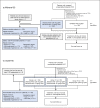Atezolizumab and Bevacizumab in Patients with Unresectable Hepatocellular Carcinoma: Pharmacokinetic and Safety Assessments Based on Hepatic Impairment Status and Geographic Region
- PMID: 34721510
- PMCID: PMC8527900
- DOI: 10.1159/000515817
Atezolizumab and Bevacizumab in Patients with Unresectable Hepatocellular Carcinoma: Pharmacokinetic and Safety Assessments Based on Hepatic Impairment Status and Geographic Region
Abstract
Introduction: Phase 1b GO30140 and phase 3 IMbrave150 studies evaluated first-line atezolizumab + bevacizumab for unresectable hepatocellular carcinoma (HCC). Here, we evaluated pharmacokinetics (PK) and safety by hepatic impairment status and geographic region.
Methods: Patients received atezolizumab 1,200 mg + bevacizumab 15 mg/kg IV every 3 weeks. Drug concentrations were evaluated by descriptive statistics and population PK. PK and adverse event frequencies were evaluated by hepatic impairment status and region.
Results: 323 IMbrave150 patients and 162 GO30140 patients were PK evaluable. Compared with IMbrave150 patients who had normal hepatic function per the National Cancer Institute Organ Dysfunction Working Group (NCI-ODWG) criteria (n = 123), patients with mild impairment (n = 171) had a geometric mean ratio (GMR) of 0.92 for cycle 1 atezolizumab area under the concentration-time curve (AUC); patients with moderate impairment (n = 27) had a GMR of 0.88. Patients in Asia ([n = 162] vs. outside [n = 161]) had a GMR of 1.25 for cycle 1 atezolizumab AUC. Compared with GO30140 patients who had normal hepatic function (NCI-ODWG [n = 61]), patients with mild impairment (n = 92) had a GMR of 0.97 for cycle 1 peak bevacizumab concentrations; those with moderate impairment (n = 9) had a GMR of 0.94. Patients in Asia (n = 111) versus outside Asia (n = 51) had a GMR of 0.94 for cycle 1 peak bevacizumab concentration. PK results were generally comparable when evaluated based on additional hepatic functional definitions (Child-Pugh or albumin/bilirubin criteria) or study enrollment in Japan. No associations between atezolizumab PK and HCC etiology were seen. Adverse event frequencies were similar across evaluated groups.
Conclusions: IMbrave150 and GO30140 patients with unresectable HCC had varying baseline hepatic impairment and high enrollment from Asia. PK data demonstrated considerable exposure overlap across groups. Treatment was tolerable across groups. No need for dose adjustment based on mild or moderate hepatic impairment or region is recommended based on this analysis.
Keywords: Atezolizumab; Bevacizumab; Clinical pharmacology; Geographic region; Hepatic impairment.
Copyright © 2021 by S. Karger AG, Basel.
Conflict of interest statement
C.S.S., P.C., D.C., S.V., and B.W. are employees of Genentech, Inc., and Roche stockholders. H.S. and D.X. are employees of F. Hoffmann-La Roche Ltd. and Roche stockholders. R.B. is an employee of Roche France and is a Roche stockholder. D.C. of Combs Consulting Services was contracted by Genentech Inc during the course of the study.
Figures




References
-
- Miller KD, Siegel RL, Lin CC, Mariotto AB, Kramer JL, Rowland JH, et al. Cancer treatment and survivorship statistics, 2016. CA Cancer J Clin. 2016 Jul;66((4)):271–89. - PubMed
-
- Llovet JM, Zucman-Rossi J, Pikarsky E, Sangro B, Schwartz M, Sherman M, et al. Hepatocellular carcinoma. Nat Rev Dis Primers. 2016 Apr 14;2:16018. - PubMed
-
- Llovet JM, Ricci S, Mazzaferro V, Hilgard P, Gane E, Blanc JF, et al. Sorafenib in advanced hepatocellular carcinoma. N Engl J Med. 2008 Jul 24;359((4)):378–90. - PubMed
LinkOut - more resources
Full Text Sources
Other Literature Sources
Research Materials

